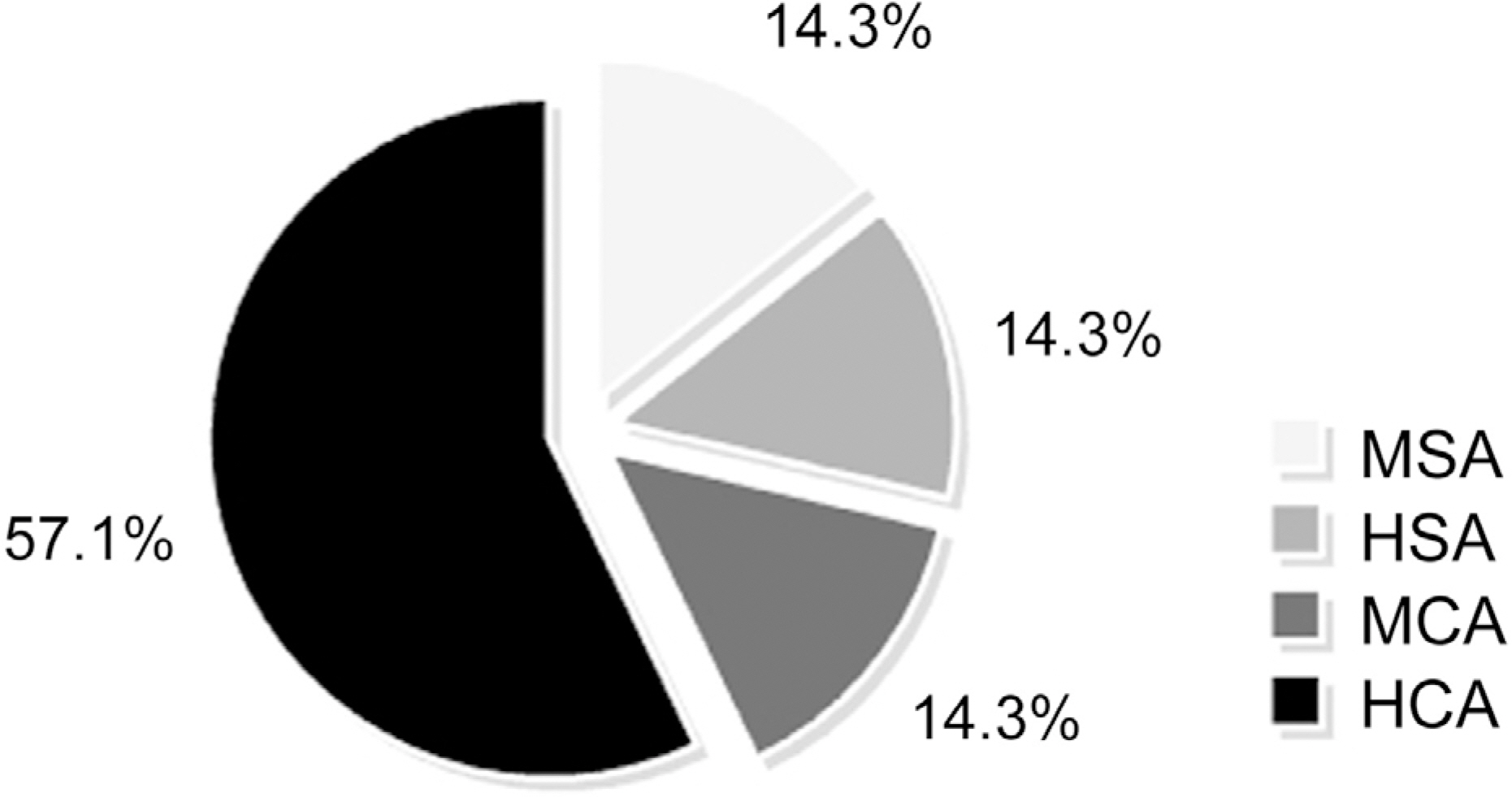J Korean Ophthalmol Soc.
2009 Nov;50(11):1686-1691.
The Association Between Amblyopia and Anisometropia in Intermittent Exotropia
- Affiliations
-
- 1Department of Ophthalmology, Gachon University Gil Medical Center, Incheon, Korea. hjpaik@gilhospital.com
Abstract
- PURPOSE
To determine the frequency of amblyopia and anisometropia in intermittent exotropia and to evaluate the relationship between anisometropia and amblyopia.
METHODS
The medical records of 471 intermittent extotropia patients, who were followed up over a period of 6 months and ranged from 3 to 15 years of age had been retrospectively reviewed. Anisometropia patients, who had either spherical or cylindrical anisometropia of more than 1.00D, were divided into 4 groups: spherical hyperopic anisometropia (SHA), spherical myopic anisometropia (SMA), cylindrical hyperopic anisometropia (CHA), and cylindrical myopic aniometropia (CMA).
RESULTS
The frequency of amblyopia in the intermittent exotropia group was 41/471 (8.7%). Amblyopia results in a significant increase in the incidence of anisometropia and a decrease in binocular function when compared with non-amblyopic patients. In the amblyopia group, 14 patients had anisometropia (34.1%) consisting of 2 patients with spherical myopic anisometropia (SMA), 2 patients with spherical hyperopic anisometropia (SHA), 2 patients with cylindrical myopic anisometropia (CMA) and 8 patients with cylindrical hyperopic anisometropia (CHA). In the anisometropia group (n=56) 14 patients (25.0%) had amblyopia and in the non-anisometropia group (n=415) 27 patients (6.5%) had amblyopia.
CONCLUSIONS
Intermittent exotropia is susceptible to amblyopia, especially when combined with anisometropia. Among the 4 types of anisometropia, cylindrical hyperopic anisometropia has a higher risk for developing amblyopia.
Keyword
MeSH Terms
Figure
Reference
-
References
1. von Noorden GK. Binocular vision and ocular motility. 5th ed.St. Louis: Mosby;1996. p. 8–40.2. Abrahamsson M, Sjostrand J. Contrast sensitivity and acuity relationship in strabismic and anisometropic amblyopia. Br J Ophthalmol. 1988; 72:44–9.
Article3. Simons K. Amblyopia characterization, treatment, and prophylaxis. Surv Ophthalmol. 2005; 50:123–66.
Article4. von Noorden GK. Amblyopia: a multidisciplinary approach. Proctor lecture. Invest Ophthalmol Vis Sci. 1985; 26:1704–16.5. Pediatric Eye Disease Investigator Group. A randomized trial of atropine vs. patching for treatment of moderate amblyopia in children. Arch Ophthalmol. 2002; 120:268–78.6. Pediatric Eye Disease Investigator Group. The clinical profile of moderate amblyopia in children younger than 7 years. Arch Ophthalmol. 2002; 120:281–7.7. Rahi JS, Dezateux C. National cross sectional study of detection of congenital and infantile cataract in the United Kingdom: role of child-hood screening and surveillance. The British Congenital Cataract Interest Group. BMJ. 1999; 318:362–5.8. Fahle M. Naso‐ temporal asymmetry of binocular inhibition. Invest Ophthalmol Vis Sci. 1987; 28:1016–7.9. Clarke M, Strong N, Buck D, et al. Intermittent exotropia. Ophthalmology. 2007; 114:1416.
Article10. Beneish R, Flanders M. The role of stereopsis and early postoperative alignment in long‐ term surgical results of intermittent exotropia. Can J Ophthalmol. 1994; 29:119–24.11. Smith K, Kaban TJ, Orton R. Incidence of Amblyopia in Intermittent Exotropia. American Orthoptic Journal. 1995; 45:90–6.
Article12. Han JH, Kim DS, Shin JC. Amblyopia and sensory fusional anomaly in intermittent exotropia. J Korean Ophthalmol Soc. 2000; 41:495–9.13. Sen DK. Anisometropic amblyopia. J Pediatr Ophthalmol Strabismus. 1980; 17:180–4.
Article14. Weakley DR Jr. The association between nonstrabismic anisometropia, amblyopia, and subnormal binocularity. Ophthalmology. 2001; 108:163–71.
Article15. Sjostrand J, Abrahamsson M. Risk factors in amblyopia. Eye. 1990; 4:787–93.
Article16. Ikeda H, Wright MJ. Is amblyopia due to inappropriate stimulation of the “sustained” pathway during development? Br J Ophthalmol. 1974; 58:165–75.
Article17. Kim HY, Chang BL. Clinical evaluation of exotropia combined with amblyopia in children. J Korean Ophthalmol Soc. 1996; 37:662–8.18. Lee SJ, Park SH, Shin H. Stereopsis in child amblyopes. J Korean Ophthalmol Soc. 1995; 36:1598–604.19. Stathacopoulos RA, Rosenbaum AL, Zanoni D, et al. Distance stereoacuity. Assessing control in intermittent exotropia. Ophthalmology. 1993; 100:495–500.20. Brooks SE, Johnson D, Fischer N. Anisometropia and binocularity. Ophthalmology. 1996; 103:1139–43.
Article21. American Academy of Ophthalmolgy. Amblyopia, Preferred Practice Pattern. San Francisco: The Academy;1997. p. 5–6.
- Full Text Links
- Actions
-
Cited
- CITED
-
- Close
- Share
- Similar articles
-
- Amblyopia and Sensory Fusional Anomaly in Intermittent Exotropia
- Clinical Evaluation of Exotropia Combined with Amblyopia in Children
- The Influence of Suppression on Axial Length Progression in Intermittent Exotropia
- The Amblyopia and Strabismus Accompanied with Anisometropia
- Clinical Features of Recurrent Intermittent Exotropia after Reoperation for Intermittent Exotropia


